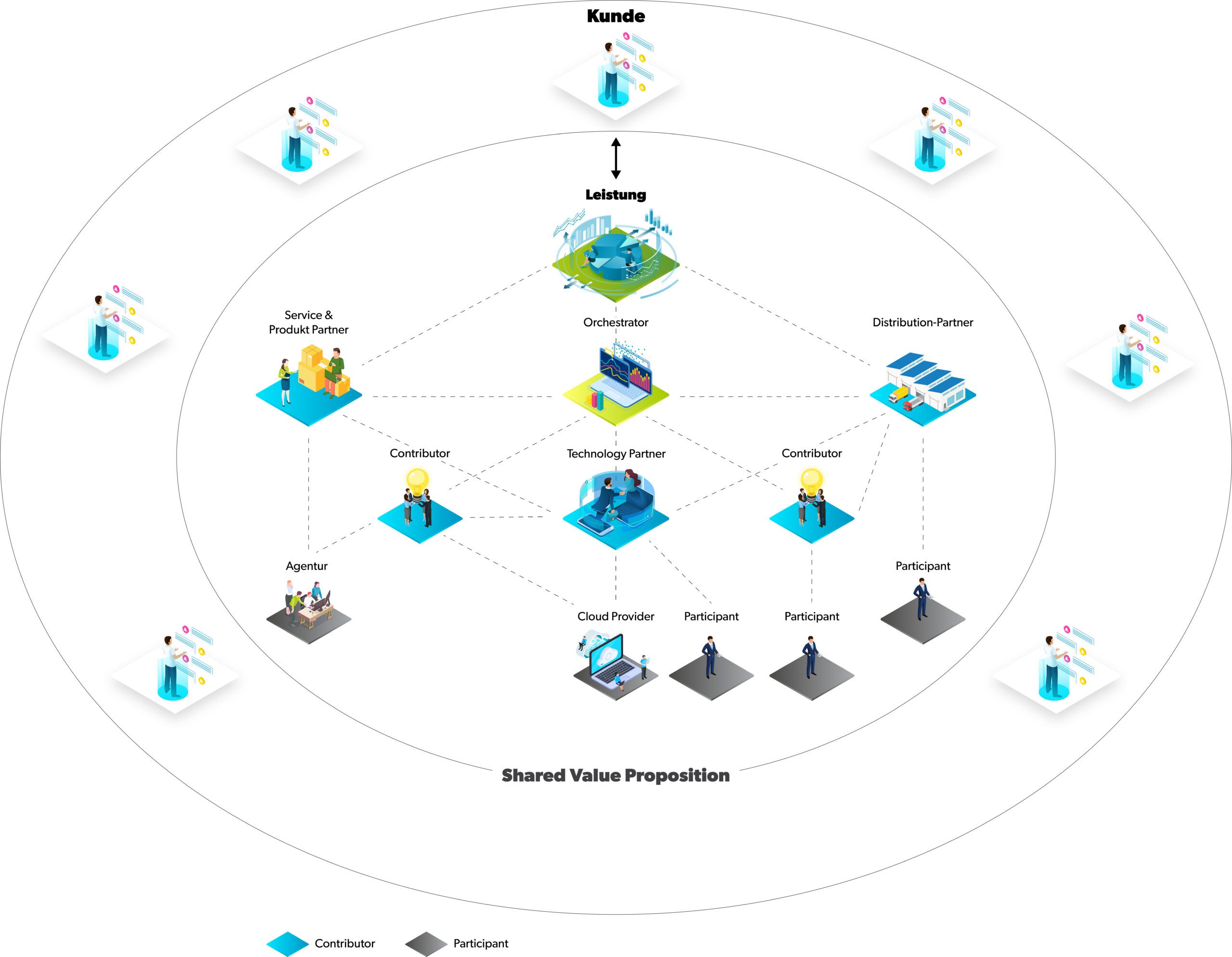From collaborations to ecosystems
The idea that collaboration with other companies brings advantages has existed for a long time. Due to the increasingly interconnected economy, technological change, and evolving end-customer needs, this rather rigid and inflexible concept of one-dimensional cooperation has evolved into ecosystems.
Ecosystems create a cohesive value proposition that is greater than the sum of the individual value propositions of the participants. By breaking down product and service boundaries, both non-industry players and established companies have the opportunity to enter new markets. Ecosystems are already widespread today. In fact, most companies in the S&P 500 Index are building ecosystems, and this trend is expected to intensify further.
According to studies, by 2025, approximately 30 percent of all economic revenues worldwide will result from ecosystems. These ecosystems seemingly guarantee companies long-term growth opportunities in terms of new services and customers.
How does an ecosystem work?
Due to the lack of a unified definition of ecosystems, there are various approaches to understanding how they function. However, within an ecosystem, two fundamental roles can often be observed that actors can assume: Orchestrator and Contributor/Participant.
Orchestrators often see themselves as initiators and lead the ecosystem. They aim to incentivize companies with different competencies—regardless of industry—to join the ecosystem. The orchestrating company acts as an intermediary, coordinating collaboration among businesses while often bringing expertise in infrastructure and platforms.
Contributors or Participants are actors who actively engage in the ecosystem. Their goal is to enhance their offerings through active collaboration with the orchestrator and other partners. In doing so, they expand and support both their own value proposition and that of the ecosystem. Additionally, there are suppliers who operate in the background, providing technical infrastructure, for example.
While assuming a role may seem straightforward in theory, it is complex in practice and should not be taken for granted but rather strategically anchored. A preliminary consideration is whether an ecosystem is even the right solution for the given challenge. Once this is clear, additional governance-related questions arise, such as legal aspects, marketing, profit distribution, or infrastructure.

The ecosystem navigator as a support tool for companies
The Ecosystem Navigator serves as a framework designed to structure the strategy development process. The focus is primarily on the strategic aspects of the ecosystem, such as the value proposition or business model, rather than on operational implementation and scaling. The navigator is applicable across industries, as traditional industry boundaries are often dissolved within an ecosystem.
To implement this new form of value creation within an ecosystem, co-creation between partners and the end customer must take place. Our experience shows that this approach presents challenges for companies. Until now, the customer experience has typically been limited to purchasing a single product or using an isolated service. However, in the future, offerings will become increasingly integrated, and industry boundaries will be further blurred.
Using the Ecosystem Navigator, a prototype ecosystem is built in an iterative process across six phases. This can follow the MVP (Minimum Viable Product) concept and is referred to as an MVE (Minimum Viable Ecosystem). Various elements—such as end-customer needs, role definitions for participants, and business model design—are covered and aligned.
The navigator provides companies with a tool that enhances understanding of ecosystems and serves as a starting point for developing their own successful ecosystem or participating in an existing one.

Conclusion – Step by step towards an ecosystem strategy
Due to the lack of standardized definitions for terms such as ecosystem, orchestrator, or participant, achieving a common understanding is critical to success. For example, platform business should not be equated with ecosystems. However, our experience shows that this misconception is deeply ingrained in many minds and could lead to different outcomes when navigating through the Ecosystem Navigator. The benefits of an ecosystem are significant: companies can connect beyond industry boundaries and unlock new revenue streams through innovative touchpoints.
In a half-day workshop, fundamental aspects such as establishing a baseline, defining framework conditions (for example, through a corporate strategy), formulating initial rough hypotheses, and identifying the customer journey to be addressed can be successfully developed. This structured approach makes the initially overwhelming and difficult-to-grasp topic of ecosystems more concrete and tangible in a manageable format that is understandable for all stakeholders.
First step: Kick-off on the topic of “Ecosystems” – Initialization & Baseline Setting as part of a workshop.
- Identification of internal stakeholders
- Creating a common understanding among all participants
- Defining framework conditions
- Planning initial steps using the Ecosystem Navigator




